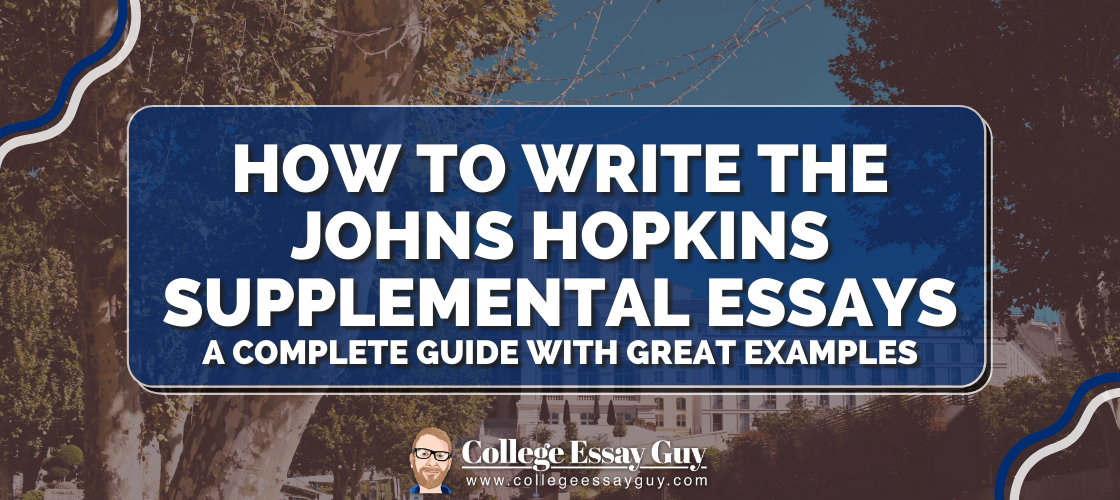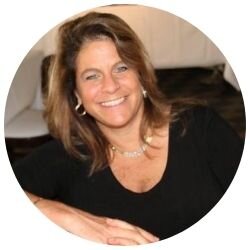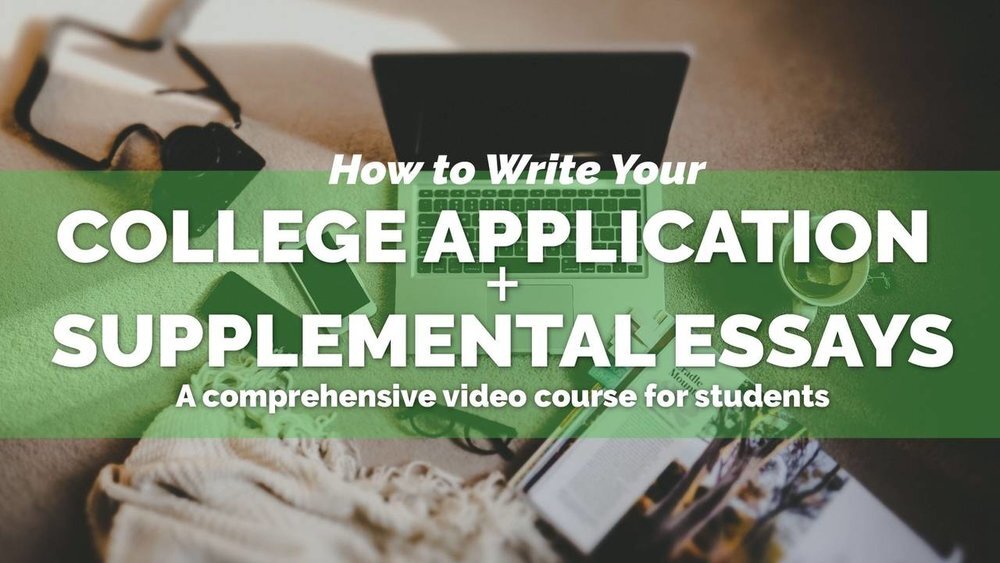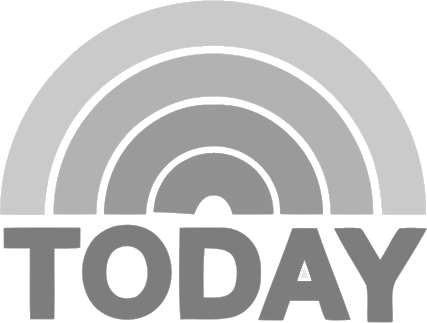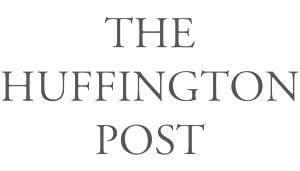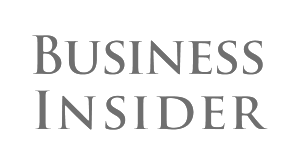This research university is renowned for its robust science and medical programs, but school officials make it clear they’re looking for more than academic stars. Each year, they fill their quads and classrooms with not just deep thinkers, but also doers.
How do you show you’re just what they’re looking for? JHU officials take the time to note that your essays are especially important in revealing to them who you are and “how you actually think.” And they give you two such opportunities: the Common App personal statement (which, hopefully, you’ve already written) and one supplemental essay, explored in detail below.
Before you write your supplemental essay, get a by-the-numbers look at Johns Hopkins’ offerings, from enrollment and tuition statistics to student life and financial aid information, on its Common Data Set. For deep insights into how America’s oldest research university envisions its role and how it wants to grow and evolve, check out its strategic plan.
And heads-up: Be careful not to write “John” Hopkins in your essay. Yes, it’s actually “Johns,” with an “s.”
What is the Johns Hopkins supplemental essay prompt?
Johns Hopkins Supplemental Essay Prompt #1
Over the past 150 years, every monumental discovery at Hopkins has started with a first step: The first draft by a Pulitzer Prize-winning author. A prototype that led to a life-changing medical invention. The first pitch that launched a new startup venture. As we commemorate the university's sesquicentennial—150 years since its founding—we continue to celebrate first steps just as much as final achievements. Tell us about an important first in your life—big or small—that has shaped you. (350 word limit)
How to Write The Johns Hopkins Supplemental Essay Prompt
Over the past 150 years, every monumental discovery at Hopkins has started with a first step: The first draft by a Pulitzer Prize-winning author. A prototype that led to a life-changing medical invention. The first pitch that launched a new startup venture. As we commemorate the university's sesquicentennial—150 years since its founding—we continue to celebrate first steps just as much as final achievements. Tell us about an important first in your life—big or small—that has shaped you. (350 word limit)
JHU is inviting you to zoom in on beginnings here—even an origin story of sorts—that highlights a first step that changed you (even if you didn’t know at the time where that step might take you).
Now, don’t overthink this. Your “first” doesn’t need to be superbly dramatic or infinitely world-changing (it certainly can be, but you don’t need something like that to write something strong here).
Here’s what really matters here: What’s an experience that has shaped you in some meaningful way?
Not sure where to start? Ask yourself these questions:
When did you first try something new (e.g., a sport, a class, a hobby, a leadership role)? What surprised you about taking that risk?
What’s a moment where you took initiative—making a big decision or taking responsbility—without the guidance or input of others? Did it shape how you make future decisions?
Have you made a mistake that shaped you in a fundamental way? Maybe it’s one that’s changed the trajectory of your resilience or creativity.
Do you have a story about a time when you connected with someone different from you in an unexpected way that gave you new insight into cultures or perspectives?
One important thing to remember here is that this essay is focused less on what you did and more on the “so what”—what does this show you about yourself, what values and qualities does it show about who you are, and how has it shaped the way you move through the world today.
While written for another (similar, but slightly longer) prompt, this example essay does a nice job of showing just how any sort of “first” can become an impactful topic.
Example essay:
In eighth grade, I created an art piece addressing a stereotype I had faced and posted it online, encouraging my friends to do the same and hashtag it #StereotypeProject. The drawing snowballed into a viral movement, gathering the attention of over 1,000 youth artists worldwide, each contributing their own stories and drawings. The Stereotype Project has since grown, extending into local schools and calling on the next generation to stand strong against the biases they face due to race, gender, sexual orientation, mental illness, and more. In a time of increasing youth activism and reminders of the potential we have as young revolutionaries, the Stereotype Project is a channel for creative expression, unity, and a means of imparting a positive impact on the world.
Running the organization, however, hasn’t always been easy. Usually one to extend myself as far as possible in fear of asking for too much of others, when it came time to launch our website, I spent many afternoons trying to teach myself programming before recruiting friends with experience. Struggling to comprehend HTML and CSS, I realized that asking for help was not a sign of defeat; no white flags were raised but rather treaties were reached, alliances made. My all-nighters were not only mine anymore—they were ours, and coming to school on two hours of sleep is much better when someone remembers to bring you coffee.
In the art world, my graphic designers and face painters taught me the value of creative problem-solving. When our school tried to stop us from working with the New Jersey Education Association, we opted to start an organization within the school itself, establishing a team all by ourselves. We ended up with a booth at our school carnival, and though perhaps not as cool as an interview published on a state website, we were able to reach those in need within our own community. While handing out stickers, we saw the excitement in students wearing their identities with pride.
Working with my team, I am reminded of the power we have as a group looking to inspire change. Like those who submit and participate in the project, we represent the power we have as young revolutionaries and the value of collaborating toward creating a better future. Our website continues to be live and accept submissions: StereotypeProject.org. (388 words)
Tips + Analysis
Think beyond the obvious. We mentioned earlier that it can feel tempting to find the most important-sounding moment from your life. But not every student has that, and that’s OK. It won’t make your response any less meaningful. You can see here that “an important first” can be as simple as a posting with a new hashtag. But as you read the student’s journey, it’s clear that it wasn’t the posting itself that was impactful; rather, it was what followed that shaped the student’s life.
“Firsts” don’t always have to be positive. Sometimes we learn the most from doing something wrong. This student describes how they tried to take on website design all on their own, trying (and failing) to teach themselves under pressure. One way you can think of the impact different experiences have had on you is by completing the “If You Really, Really Knew Me” exercise. Then you can use some of your responses to show how you’ve become who you are, and how that is shaping what you’ll bring to the college.
One “first” can cascade into others. You’ll notice this student starts off by sharing the story of their first post, but it’s followed by others, like teaching themselves something new and being willing to ask for help when things didn’t go right.
Be willing to be vulnerable. It can feel risky to try something new—to put yourself out there without knowing how people will react. We’re sure this student never expected this reaction to their work, but it’s been transformative—not just to the student who’s found themselves at the center of a new organization, but also to the students who have found a space to voice their experiences.
Let’s take a look at another example that also does a solid job of answering the prompt.
Example essay:
Despite the clamor at the bus station, I remained fixated on the person’s leg. His prosthetic limb had restored his ability to move, but he didn’t have access to other subconscious privileges, like wiggling his toes. Weighing the benefits and limitations of these current prosthetics, I realized that these were placeholders, not replacements, for limbs. Wanting to create more innovative prosthetics shaped my interest in applying science and engineering to biological and mental health issues.
I first did this through research, finding an inexpensive alternative to water filtration for developing countries by working with others to analyze the role of nano-patterns in polymer supersaturation. While the results weren’t significant, it piqued my curiosity, motivating me to explore innovative solutions to nuanced issues. But what drew me back to the lab wasn’t research’s long-term benefits: it was the hope it offered, a possible solution to a seemingly unresolvable issue.
Energized by the enthusiasm I’d experienced in the lab, I also wanted to make an immediate impact on my community. After a local middle school lost its STEM extracurricular funding, our robotics team established and mentored FIRST Lego League there, working with children to create functioning products and emphasizing collaborative learning over lecturing.
But this was one school. One issue. I wanted to continue educating people about global problems through engineering. Such an opportunity arose after five district-wide suicides in forty days. To promote mental health awareness and discourage drug misuse, I worked with friends to create braiNformation, describing depression signs and drugs’ effects, and worked with Rise Above Colorado to increase awareness. Through research and community outreach, I’ve grown to embrace proactive, unorthodox problem-solving.
When I sat in on Dr. Joel Bader’s Systems Biology of the Cell lecture, I was fascinated by the open collaboration between Dr. Bader and the class as they applied calculus to the central dogma of biology. To me, this collaboration is a microcosm of JHU’s community. Through Psychopathology for Public Health and JHU’s Active Minds chapter, I’d continue learning about global mental wellness issues and work with others to expand braiNformation’s reach. But I wouldn’t stop there. I hope to continue solving larger clinical problems through the BME Undergraduate Design Team and researching changes in brain components to understand neurodegenerative diseases in Dr. Tilak Ratnanather’s lab. At JHU, I’d have many opportunities to apply classroom learning, making profound impacts on the world through cutting-edge, collaborative endeavors.
— — —
Tips + Analysis:
Name your “first” moment in a vivid, specific way. You’ll see this student opened with them fixated on a fellow bus rider’s prosthetic limb. That singular image instantly draws the reader in and anchors the essay in a concrete first moment. Rather than demonstrating a general interest in science, the student ties their essay into a very particular observation that changes how they see (and interact with) the world. You can do the same thing by picking a moment you remember clearly and then using your five senses to elaborate on what you noticed, how you felt, and what you thought.
Show the progression from the first step to sustained action. The student shows a clear trajectory in their response about how their bus station moment continued into research, community STEM work and even mental health advocacy. Each paragraph builds on the one before, showing how that initial happenstance encounter sparked ongoing curiosity and impact. Consider how your own “first step” has a similar ripple effect. Even if it’s small or incremental, how did that set you on a path of discovery?
Connect your moment to your values. You’ll notice the writer doesn’t stop at just noticing the prosthetic; instead, they also begin to reflect on what it means (“placeholders, not replacements for limbs”) and how that motivates them to create innovative solutions. That simple reflection is a great demonstration of self-awareness—a key part of JHU’s prompt. We encourage you to also name the values you want to show in your essay (if you’re not sure what they are, check out this blog on the topic). By asking yourself questions like “What did this moment make me think or feel?” or “How was I inspired to change and grow?” you can show how this experience truly mattered to you personally.
Want advice on dozens of other supplemental essays? Click here.
Nicole learned how to tell other people’s stories after a 30+-year career as a newspaper reporter, covering both the mundane and the unforgettable, from serial killer Duane Owen’s retrial, to the Bush/Gore nail-biter, to the homeless family of four who found refuge in a storage unit. Her ideal day is spent playing Cribbage with her dad, beating her husband at RummiKub and planning the next girls trip with her teenage daughters.
Top values: Creativity | Growth | Meaningful Work
TRY OUT THE COLLEGE APPLICATION + SUPPLEMENTAL ESSAYS COURSE
Create amazing supplemental essays for the most selective schools, polish your activities list, and complete everything else with ease and joy. Learn more here.

